|
All members of the G2 series of cooled CCD cameras are designed for
low-light imaging applications, requiring very high sensitivity and
very low noise and dark current. However, the G2 series comprises
numerous model, each suitable for a particular application area in
astronomical research, astro-photography, microscopy, life-sciences,
material research etc.
G2-0402, G2-1600 and G2-3200 models are equipped with
Full-Frame, NABG detectors. Their features make them especially
suitable for research applications:
Very high sensitivity with peak QE above 80%. High full-well capacity (up to 100 ke- in the case of G2-0402 and G2-1600
models). Non-ABG detectors with linear response to light.
G2-8300 still employs Full-Frame architecture CCD, but
thanks to ABG this particular model is especially popular among
astro-photographers:
KAF8300 CCD detector is equipped with anti-blooming gate
(ABG), which protects electron leaks from saturated pixels to
neighboring pixels when a bright star appears in the field of
view. Detector corresponds to the so-called “4/3 standard”
and its imaging area 18.1 × 13.7 mm is the largest of all
detectors used in the G2 series. High resolution (more than 8 MPx) and relatively small pixels
(5,4 × 5,4 μm)
makes this camera ideal for use with short focal length telescopes
(or with ordinary photographic lenses).
G2-2000 and G2-4000 models use Interline-Transfer CCD
detectors, bringing some unique features:
Electronic shuttering allows very short exposures of bright
objects. Fast windowing allows reading of arbitrary detector sub-frame
faster than in the case of KAF CCD detectors. Anti-blooming gate ensures proper images of bright stars in
the field of view without blooming spikes, but it still does not
harm linearity, so these cameras can also be used for research
applications.
All members of the G2 series share the same design, making
them powerful research and imaging tools:
Lowest possible read noise, limited by CCD detector
itself. Uniform frames without artifacts. High dynamic range, 16-bits digitization. Efficient and precisely regulated cooling with optional heat
exchanger for liquid coolant. Compact camera head, small and lightweight enough to be
attached even to small telescopes. Integrated all-in-one design with USB and power connectors
directly on the camera head. Integrated mechanical shutter not to bother with covering the
telescope when taking dark frames. Optional integrated filter wheel. Single-voltage power supply enabling operation from
12V battery or “brick” adapter. Plug and play installation. Robust construction to sustain every-day usage. Rich software support.
No matter if your target is reliable scientific data or beautiful
images of deep-sky objects, G2 CCD cameras are able to provide
both.
G2 Camera Overview
G2 camera head is designed to be easily used with a set
of accessories to fulfill various observing needs. Camera head
itself is manufactured in two different variants:
Camera with internal filter wheel. Camera with control port for external filter wheel. This
model allows attachment of several variants of external filter
wheels with various number of filter positions and
sizes.
Camera head and numerous accessories comprise imaging system,
capable to be tailored for many applications.
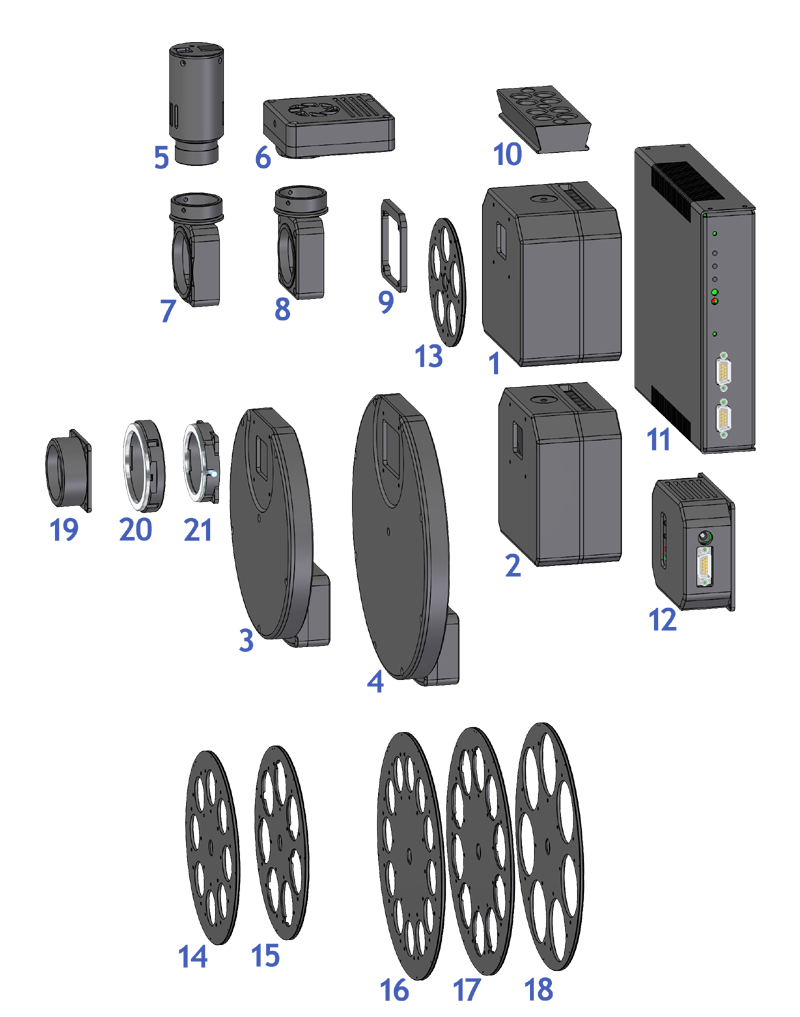
G2 camera head with Internal Filter Wheel (5 or 6
positions) G2 camera head with Internal Filter Wheel (5 or 6
positions) External Filter Wheel “XS” size (7 or 8
positions) External Filter Wheel “S” size (10 or 12
positions) G0 guider camera G1 guider camera Off-Axis Guider with M48×0.75 thread Off-Axis Guider with M42×0.75 thread (T2) Spacer compensating IFW and EFW back focal
distance 1.75” dovetail rail for G2 camera head Gx Camera Ethernet Adapter (x86 CPU) Gx Camera Ethernet Adapter (ARM CPU) 8-positions external filter wheel “XS” for 1.25”/D31 mm
filters 7-positions external filter wheel “XS” for D36 mm
filters 12-positions external filter wheel “S” for 1.25”/D31 mm
filters 10-positions external filter wheel “S” for D36 mm
filters 7-positions external filter wheel “S” for 2”/D50 mm
filters M42×0.75 (T-thread) or M48×0.75 threaded adapters, 55 mm
BFD Canon EOS lens adapter Nikon lens adapter
G2 cameras are designed to work in cooperation with a
host Personal Computer (PC). As opposite to digital still
cameras, which are operated independently on the computer, the
scientific slow-scan, cooled cameras usually require computer
for operation control, image download, processing and storage
etc. To operate G2 camera, you need a computer which:
Is compatible with a PC standard. Runs a modern 32-bit or 64-bit Windows operating
system. Provides at last one free USB port. Alternatively it is possible to use the Gx Camera
Ethernet Adapter. This device can connect up to four Gx cameras
of any type (not only G2, but also large-format G3 and G4 as
well as G0 and G1 guiders) and offers 1 Gbps and 10/100 Mbps
Ethernet interface for direct connection to the host PC. Because
the PC then uses TCP/IP protocol to communicate with the
cameras, it is possible to insert e.g. WiFi bridge or other
networking device to the communication path.
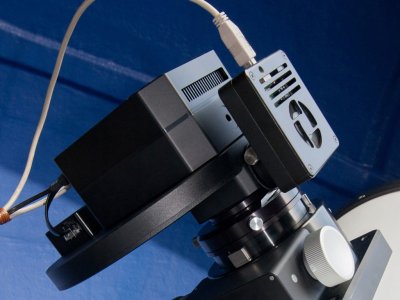
G2 camera, External Filter Wheel, Off-Axis Guider
adapter and G1 guider camera on the telescope G2 Camera Models
Available models of G2 CCD cameras:
| Model |
CCD Chip |
ABG |
Color mask |
Resolution |
Pixel size |
Imaging area |
Download time |
| G2-0402 |
KAF-0402ME |
No |
None |
768 × 512 |
9 × 9 μm |
6.9 × 4.6 mm |
~ 0.5 s |
| G2-1600 |
KAF-1603ME |
No |
None |
1536 × 1024 |
9 × 9 μm |
13.8 × 9.2 mm |
~ 1.8 s |
| G2-3200 |
KAF-3200ME |
No |
None |
2184 × 1472 |
6.8 × 6.8 μm |
14.9 × 10 mm |
~ 3.8 s |
| G2-8300 |
KAF8300 Monochrome |
>1000× |
None |
3358 × 2536 |
5.4 × 5.4 μm |
18.1 × 13.7 mm |
~ 9.8 s |
| G2-8300C |
KAF8300 Color |
>1000× |
Bayer RGBG |
3358 × 2536 |
5.4 × 5.4 μm |
18.1 × 13.7 mm |
~ 9.8 s |
| G2-2000 |
KAI-2020 Monochrome |
>300× |
None |
1604 × 1204 |
7.4 × 7.4 μm |
11.9 × 8.9 mm |
~ 2.1 s |
| G2-2000C |
KAI-2020 Color |
>300× |
Bayer RGBG |
1602 × 1202 |
7.4 × 7.4 μm |
11.9 × 8.9 mm |
~ 2.1 s |
| G2-4000 |
KAI-4022 Monochrome |
>300× |
None |
2056 × 2062 |
7.4 × 7.4 μm |
15.2 × 15.3 mm |
~ 4.5 s |
| G2-4000C |
KAI-4022 Color |
>300× |
Bayer RGBG |
2054 × 2060 |
7.4 × 7.4 μm |
15.2 × 15.3 mm |
~ 4.5 s |
G2 Camera Technical Specifications
CCD Chip
G2 cameras use OnSemi KAF Full-Frame and KAI
Interline-Transfer CCD detectors. Advanced manufacturing
techniques like transparent electrodes and microlensing ensure
more than 80 % peak quantum
efficiency on some models. The inherent dark current of these
detectors is very low compared to other scientific-grade CCDs,
so the resulting image S/N ratio is very good.
Model G2-0402
G2-0402 model uses 0.4 MPx OnSemi
KAF-0402ME NABG Full-Frame CCD chip.
| Resolution |
768 (H) × 512 (V)
pixels |
| Pixel size |
9 μm (H) × 9 μm (V) |
| Imaging area |
6.9 mm (H) × 4.6 mm (V) |
| Full well capacity |
~100,000 e- |
| Output node capacity |
~220,000 e- |
| Anti-blooming gate |
No |
| Dark current |
1 e-/s/pixel at 0 °C |
| Dark signal doubling temperature |
6.3 °C |
KAF-0402ME CCD chip specifications KAF-0402ME CCD chip and its Quantum
Efficiency Model G2-1600
G2-1600 model uses 1.6 MPx OnSemi
KAF-1603ME NABG Full-Frame CCD chip.
| Resolution |
1536 (H) × 1024 (V)
pixels |
| Pixel size |
9 μm (H) × 9 μm (V) |
| Imaging area |
13.8 mm (H) × 9.2 mm (V) |
| Full well capacity |
~100,000 e- |
| Output node capacity |
~220,000 e- |
| Anti-blooming gate |
No |
| Dark current |
1 e-/s/pixel at 0 °C |
| Dark signal doubling temperature |
6.3 °C |
KAF-1603ME CCD chip specifications KAF-1603ME CCD chip and its Quantum
Efficiency Model G2-3200
G2-3200 model uses 3.2 MPx OnSemi
KAF-3200ME NABG Full-Frame CCD chip.
| Resolution |
2184 (H) × 1472 (V)
pixels |
| Pixel size |
6.8 μm
(H) × 6.8 μm (V) |
| Imaging area |
14.9 mm (H) × 10 mm (V) |
| Full well capacity |
~55,000 e- |
| Output node capacity |
~110,000 e- |
| Anti-blooming gate |
No |
| Dark current |
0.8 e-/s/pixel at
0 °C |
| Dark signal doubling |
6 °C |
KAF-3200ME CCD chip specifications KAF-3200ME CCD chip and its Quantum
Efficiency Model G2-8300
G2-8300 camera uses 8 MPx OnSemi KAF8300 ABG Full Frame
CCD detectors with 4/3 format.
| Resolution |
3358 (H) × 2536 (V)
pixels |
| Pixel size |
5.4 μm
(H) × 5.4 μm (V) |
| Imaging area |
18.1 mm (H) × 13.7 mm (V) |
| Full well capacity |
~25,000
e-- |
| Anti-blooming gate |
1000× |
| Dark current |
0.2 e-/s/pixel at
0 °C |
| Dark signal doubling temperature |
5.8 °C |
KAF-0402ME CCD chip specifications KAF8300 CCD chip and its Quantum
Efficiency Model G2-2000
G2-2000 model uses 2 MPx OnSemi ABG
Inteline-Transfer KAI-2020 CCD chip.
| Resolution |
1604 (H) × 1204 (V)
pixels |
| Pixel size |
7.4 μm
(H) × 7.4 μm (V) |
| Imaging area |
11.9 mm (H) × 8.9 mm (V) |
| Full well capacity |
~40,000 e- |
| Anti-blooming gate |
300× |
| Dark current |
0.3 e-/s/pixel at
0 °C |
| Dark signal doubling |
7 °C |
KAI-2020 CCD chip specifications KAI-2020 CCD chip and its Quantum
Efficiency Model G2-4000
G2-4000 model uses 4 MPx OnSemi ABG
Inteline-Transfer KAI-4022 CCD chip.
| Resolution |
2056 (H) × 2062 (V)
pixels |
| Pixel size |
7.4 μm
(H) × 7.4 μm (V) |
| Imaging area |
15.2 × 15.3 mm |
| Full well capacity |
~40,000 e- |
| Anti-blooming gate |
300× |
| Dark current |
0.3 e-/s/pixel at
0 °C |
| Dark signal doubling |
7 °C |
KAI-4022 CCD chip specifications KAI-4022 CCD chip and its Quantum
Efficiency Camera Electronics
16-bit A/D converter with correlated double sampling
ensures high dynamic range and CCD chip-limited readout
noise.
Fast USB interface ensures image download time within
seconds. Maximum length of single USB cable is 5 m. This length can be extended for instance
to 10 m by using single USB hub
or USB active extender cable.
Connection to practically unlimited distance can be
achieved with the Gx Camera Ethernet Adapter device, which
allows connection to up to 4 Gx cameras through 1 Gbps Ethernet interface and TCP/IP
protocol.
| ADC resolution |
16 bits |
| Sampling method |
Correlated double sampling |
| Read modes |
Preview mode |
| |
Low Noise mode |
| Horizontal binning |
1 to 4 pixels |
| Vertical binning |
1 to 4 pixels |
| Sub-frame readout |
Arbitrary sub-frame |
| Computer interface |
USB 2.0 High Speed |
| |
USB 1.1 Full Speed compatible |
Camera electronics specifications Image download time depends on the CCD chip used in
particular camera model. Also the read noise depends on the
chip as well as on the read mode.
Preview read mode provides system read noise approx.
1 or 2 e- above CCD
chip read noise. Low Noise read mode is somewhat slower, but ensures
system read noise roughly equal to the
manufacturer-specified chip read noise.
Model G2-0402
| Gain |
1.5 e-/ADU
(1 × 1 binning) |
| |
2.0 e-/ADU (other
binnings) |
| System read noise |
14 e- RMS (Low Noise mode) |
| |
16 e- RMS (Preview
mode) |
| Full frame download |
0.7 s (Low Noise mode) |
| |
0.5 s (Preview mode) |
G2-0402 electronics specifications Model G2-1600
| Gain |
1.5 e-/ADU
(1 × 1 binning) |
| |
2.0 e-/ADU (other
binnings) |
| System read noise |
14 e- RMS (Low Noise mode) |
| |
16 e- RMS (Preview
mode) |
| Full frame download |
2.6 s (Low Noise mode) |
| |
1.8 s (Preview mode) |
G2-1600 electronics specifications Model G2-3200
| Gain |
0.8 e-/ADU
(1 × 1 binning) |
| |
1.3 e-/ADU (other
binnings) |
| System read noise |
7 e- RMS (Low Noise mode) |
| |
10 e- RMS (Preview
mode) |
| Full frame download |
5.5 s (Low Noise mode) |
| |
3.8 s (Preview mode) |
G2-3200 electronics specifications Model G2-8300
| Gain |
0.4 e-/ADU
(1 × 1 binning) |
| |
0.8 e-/ADU (other
binnings) |
| System read noise |
8 e- RMS (Low Noise mode) |
| |
9 e- RMS (Preview
mode) |
| Full frame download |
14.2 s (Low Noise mode) |
| |
9.8 s (Preview mode) |
G2-8300 electronics specifications Model G2-2000
| Gain |
0.5 e-/ADU
(1 × 1 binning) |
| |
0.8 e-/ADU (other
binnings) |
| System read noise |
7 e- RMS (Low Noise
mode) |
| |
9 e- RMS (Preview
mode) |
| Full frame download |
3.1 s (Low Noise mode) |
| |
2.1 s (Preview mode) |
G2-2000 electronics specifications Model G2-4000
| Gain |
0.5 e-/ADU
(1 × 1 binning) |
| |
0.8 e-/ADU (other
binnings) |
| System read noise |
7 e- RMS (Low Noise
mode) |
| |
9 e- RMS (Preview
mode) |
| Full frame download |
6.7 s (Low Noise mode) |
| |
4.5 s (Preview mode) |
G2-4000 electronics specifications Notes:
Binning can be combined independently on both
axes. Download times are valid for USB 2.0 host and may vary depending on USB
Hubs, host PC etc.
Chip Cooling
Regulated two-stage thermo-electric chip cooling up to
50 °C below ambient temperature
with forced air cooling and +/-0.1 °C temperature precision ensure very low
dark current for long exposures.
| CCD chip cooling |
Thermoelectric (Peltier modules) |
| TEC modules |
Two stages |
| Max. Δ
T |
50 °C below ambient
maximum |
| |
45 °C below ambient
typical |
| Regulation precision |
0.1 °C |
| Hot side cooling |
Forced air cooling (fan) |
Chip cooling specifications 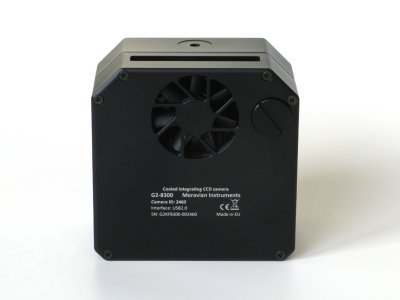
Fan and air output vents on the back side of the
camera Notes:
It is not recommended to cool the chip to the maximum
temperature difference, else the camera cannot guarantee
temperature stability when the ambient air temperature
rises. It is usually practical to set the temperature so the
cooling utilization varies around 90%. This provides enough
reserve in cooling power to keep the CCD temperature even if
the ambient temperature rises several degrees
Celsius. Water-assisted cooling is available for all G2
cameras. Contact the manufacturer for details. The cooling performance depends on the environmental
conditions and also on the power supply. If the power supply
voltage drops below 12 V, the
maximum temperature difference is lower.
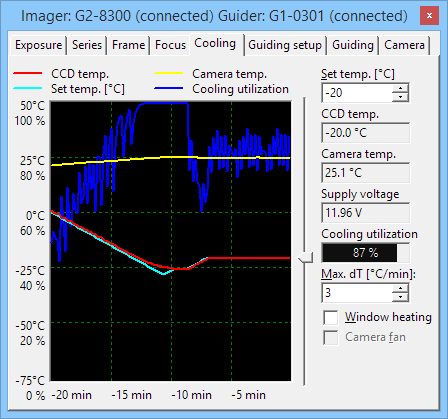
Cooling tab of the CCD Camera control tool in the
SIPS software package Mechanical Specifications
Compact and robust camera head measures only 114 × 114 × 65 mm
(approx. 4.5 × 4.5 × 2.6 inches). A variant with internal
filter wheel is thicker and measures
77.5 mm (approx.
3 inches). The head is CNC-machined from high-quality aluminum
and black anodized. The head itself contains USB-B (device)
connector and 12 V DC power plug. Integrated mechanical
shutter allows streak-free image readout, as well as automatic
dark frame exposures, which are necessary for unattended,
robotic setups. Integrated filter wheel contains 5 positions
for standard 1.25-inch threaded filter cells. A variant of
filter wheel with 6 positions for the same filters without
cells (only a glass) is also available.
G2 camera without filter wheel, with internal
filter wheel and with attached external filter wheel (left).
USB connector is on left side and power connector on right
side of the camera head.
| Internal mechanical shutter |
Yes, blade shutter |
| Shortest exposure time |
0.1 s |
| Longest exposure time |
Limited by chip saturation only |
| Internal filter wheel |
5 positions for 1.25" threaded
filter cells or for D31 mm
unmounted filters |
| |
6 positions for 1" or D26.5 mm unmounted filters |
| Head dimensions |
114 mm × 114 mm × 77.5 mm (with internal filter wheel) |
| |
114 mm × 114 mm × 65 mm
(without filter wheel) |
| Back focal distance |
29 mm (with internal
filter wheel) |
| |
16.5 mm (without filter wheel) |
| |
33.5 mm (with external filter wheel) |
| Camera head weight |
1.15 kg (with internal filter wheel) |
| |
1.05 kg (without filter wheel) |
| |
1.70 kg (with “XS” external filter
wheel) |
| |
1.95 kg (with “S” external filter
wheel) |
Mechanical specifications Regardless if the camera is equipped with filter wheel or
not, the front view dimensions are the same. Also mounting
adapter holes are the same, so both camera variants are
compatible with the same set of telescope/lens adapters.
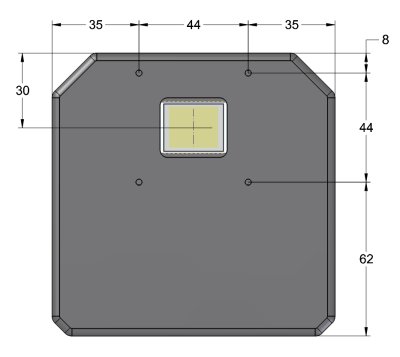
G2 camera with Internal Filter Wheel front view
dimensions G2 camera with Internal Filter Wheel side (left)
and bottom (right) view dimensions If the internal filter wheel is missing, the only
mechanical difference is a thinner front shell of the camera
head. This naturally affects Back Focal Distance, but
mechanical spacers, compensating for different BFD are
available (see the system diagram in the “G2 Camera
Overview” sub-chapter above).
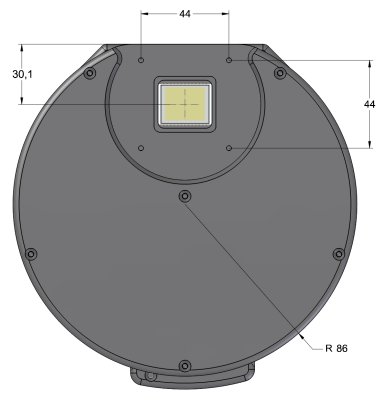
G2 camera with “XS” External Filter Wheel
front view dimensions G2 camera with “XS” External Filter Wheel
side (left) and bottom (right) view dimensions The “S” sized External Filter Wheel diameter is
greater (see External Filter Wheels), but the back focal
distance of all external filter wheels is identical.
Power supply
The 12 V DC power supply adapter enables camera
operation from arbitrary power source including batteries,
wall adapters etc. Universal 100–240 V AC/50–60 Hz,
60 W “brick” adapter is
supplied with the camera. Although the camera power
consumption does not exceed 30 W,
the 60 W power supply ensures
noise-free operation.
| Camera head supply |
12 V DC |
| Camera power consumption |
15 W without
cooling |
| |
40 W with 100%
cooling |
| Power connector |
5.5/2.5 mm, center + |
| Adapter input voltage |
100-240 V AC/50-60 Hz |
| Adapter output voltage |
12 V DC/5 A |
| Adapter maximum power |
60 W |
Power supply specifications Notes:
Camera power consumption is measured on the AC outlet
of the 12 V power
supply. The camera contains its own power supplies inside, so
it can be powered by unregulated 12 V DC power source — the input voltage can be anywhere between 10
and 14 V. However, some
parameters (like cooling efficiency) can degrade if the
supply drops below 11 V. G2 CCD camera measures its input voltage and provides
it to the control software. Input voltage is displayed in
the Cooling tab of the CCD Camera
control tool in the SIPS. This feature is important
especially if you power the camera from batteries.
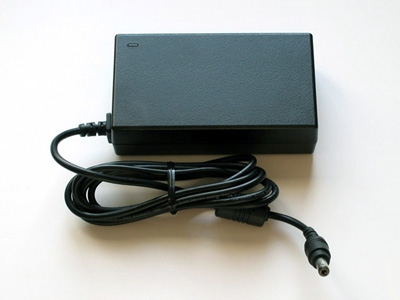
12 V DC/5 A power
supply adapter for the G2 Camera Warning: The power connector on the camera head uses
center-plus pin. Although all modern power supplies use this
configuration, always make sure the polarity is correct if you
use own power source. Optional accessories
Camera head can be combined with various accessories according
to the requirements of the target application (optical system,
used filters, guiding, etc.).
Telescope Adapters
Various telescope and lens adapters for the G2 cameras are
offered. Users can choose any adapter according to their needs
and another adapters can be ordered separately.
It is possible to choose from the following telescope/lens
adapters:
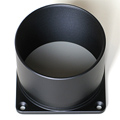 |
| 2" barrel adapter |
| Adapter for 2" focusers. |
|
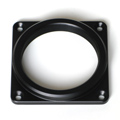 |
| T-thread short |
| M42 × 0.75 inner
thread, 7.5 mm thick. |
|
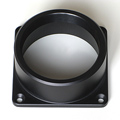 |
| T-thread with 55 mm
BFD |
| M42 × 0.75 inner
thread. |
| Preserves 55 mm back focal distance. |
|
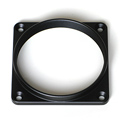 |
| M48 × 0.75 thread
short |
| M48 × 0.75 inner
thread, 7.5 mm thick. |
|
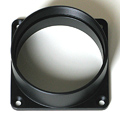 |
| M48 × 0.75 thread
with 55 mm BFD |
| M48 × 0.75 inner
thread. |
| Preserves 55 mm back focal distance. |
|
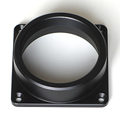 |
| Pentax (Praktica) lens adapter |
| M42 × 1 mm inner
thread. |
| Preserves 45.5 mm back focal distance. |
|
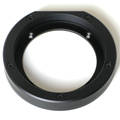 |
| M68 × 1 thread
adapter |
| Adapter with inner thread M68 × 1. |
|
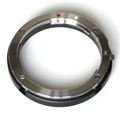 |
| Canon EOS lens adapter |
| Standard Canon EOS bayonet adapter. |
|
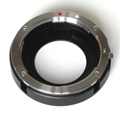 |
| Canon EOS clip lens adapter |
| Canon EOS bayonet adapter with the possibility to
insert “clip” filter. |
| Can be used on cameras with internal filter wheel
only. |
|
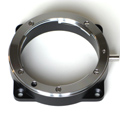 |
| Nikon F lens adapter |
| Standard Nikon F bayonet adapter. |
|
External Filter Wheels
When there is no filter wheel inside the camera head, all
electronics and firmware, intended to control it, stays idle.
These components can be utilized to control external filter
wheel with only little changes. Also the camera front shell
can be manufactured thinner, the space for filter wheel is
superfluous.
G2 camera with External Filter Wheel, Off-Axis
Guider and G1 Guiding Camera (left), opened external filter
wheel case (right) External filter wheels are described in detail here.
Off-Axis Guider adapters
The G2 off-axis guider (OAG) is designed to allow
attachment of any guiding camera with 1.25" eyepiece nose,
although the nose must be somewhat shorter to achieve focus.
G0 cameras are designed to achieve focus with G2OAG and a
special shorter version of 1.25" nose with C-mount thread is
available for all G1 cameras. Any camera with CS-mount (short
version of C-mount standard) can use this adapter to be
attached to G2OAG.
Off-Axis guider adapters are available with
M42×0.75 mm (T-thread) or M48×0.75 mm threads Off-Axis Guider adapters are described in detail here.
Guiding cameras
G0 and G1 cameras are completely independent devices with
their own USB connection to the host PC. They are mentioned
here only not to omit an important part of the whole
system.
G1-0301 standalone guiding/imaging camera is
equipped with USB connection and standard
“AutoGuider” port G0 and G1 cameras can be used on the G2 OAG, on standalone
guiding telescope or for any other imaging purpose, like Moon
or planetary imaging etc. Both G0 and G1 camera can share the
Gx Camera Ethernet Adapter with up to 3 other Gx cameras to be
accessed over network.
G0 and G1 guider cameras are described in detail here.
Attaching camera head to telescope mount
G2 cameras heads are equipped with “tripod” thread
(0.25”) on the top side. This thread can be used to attach
1.75 inch “dovetail bar” (Vixen standard). It is then
possible to attach the camera head, e.g. equipped with
photographic lens, directly to various telescope mounts
supporting this standard.

1.75" bar for standard telescope mounts Spare desiccant containers
The G2 cameras are supplied with silicagel container,
intended to dry the CCD cold chamber. This container can be
unscrewed and desiccant inside can be dried in the owen (see
the camera User's Manual).
Container shipped with the camera by default does not
exceed the camera head outline. It is equipped with a slot for
tool (of for just a coin), allowing releasing and also
tightening of the container.
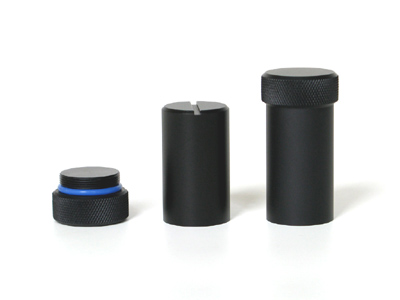
Standard container (middle) and container for
tool-less manipulation (right) It is possible to order spare container, which makes
desiccant replacement easier and faster. It is possible to dry
the spare container with silicagel and then only to replace it
on the camera. Spare container is supplied including the
air-tight cap.
Spare container can be supplied also in variant, allowing
manipulation without tools. But this container is longer and
exceeds camera outline. If the space behind the camera is not
critical, this container can make desiccant exchange even
easier.
Camera head color variants
Camera head is available in several color variants of the
center plate. Visit manufacturer's web pages for current
offering.
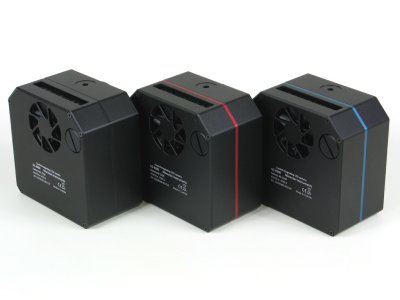
G2 camera color variants Software Support
Powerful SIPS (Scientific Image Processing System) software
supplied with the camera allows complete camera control
(exposures, cooling, filters) with automatic sequences and
complete image calibration. SIPS also supports advanced tools like
Image Add tool with automatic sub-pixel image alignment, (L)RGB
Add tool, Image Blink tool, image filters and many more
functions.
Scientific Image Processing System SIPS software package is freely available for download from this www site.
Drivers for ASCOM standard as well as native drivers for
third-party software are also available (e.g. TheSkyX, MaxIm DL,
AstroArt, etc.). Visit the download page of this web site for current list
of available drivers, please.
Automatic guiding
SIPS software package allows automatic guiding of the
astronomical telescope mounts using separate guiding camera.
Proper and reliable automatic guiding utilizing the
computational power of Personal Computer (e.g. calculation of
star centroid allows guiding with sub-pixel precision) is not
simple task. Guiding complexity corresponds to number of
parameters, which must be entered (or automatically
measured).
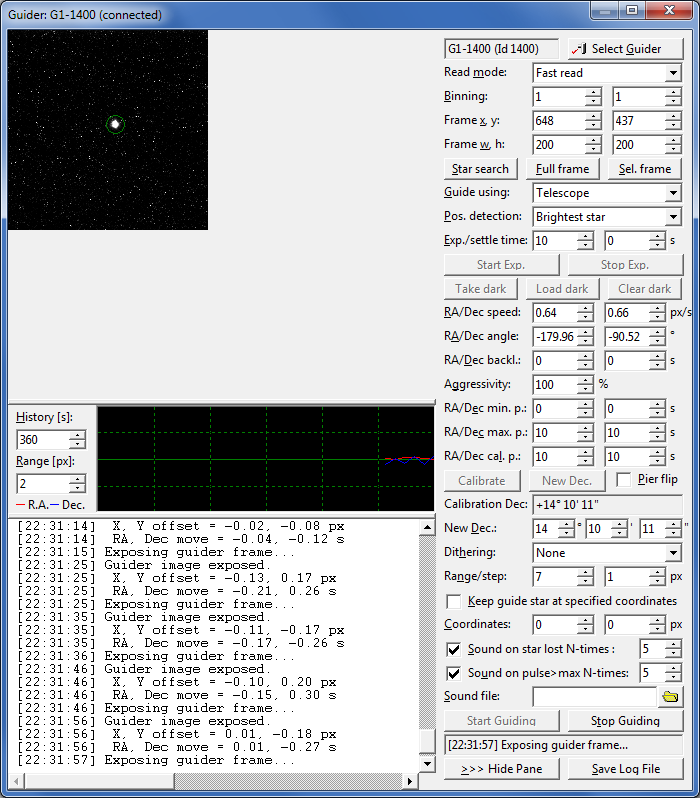
The SIPS “Guider” tool window The “Guiding” tool allows switching of autoguiding
on and off, starting of the automatic calibration procedure
and recalculation of autoguiding parameters when the telescope
changes declination without the necessity of new calibration.
Also swapping of the German Equatorial mount no longer
requires new autoguider calibration. There is also a graph
showing time history of guide star offsets from reference
position in both axes. The length of graph history as well as
the graph range can be freely defined, so the graph can be
adjusted according to particular mount errors and periodic
error period length. Complete log of calibration procedure,
detected offsets, correction pulses etc. is also shown in this
tool. The log can by anytime saved to log file.
An alternative to classic autoguiding is the inter-image
guiding, designed for modern mounts, which are precise enough
to keep tracking with sub-pixel precision through the single
exposure, and irregularities only appear on the
multiple-exposure time-span. Inter-image guiding then performs
slight mount position fixes between individual exposures of
the main camera, which eliminates “traveling” of the
observed objects through the detector area during observing
session. This guiding method uses main imaging camera, it does
not use another guiding camera and naturally does not need
neither OAG nor separate guiding telescope to feed the light
into it.
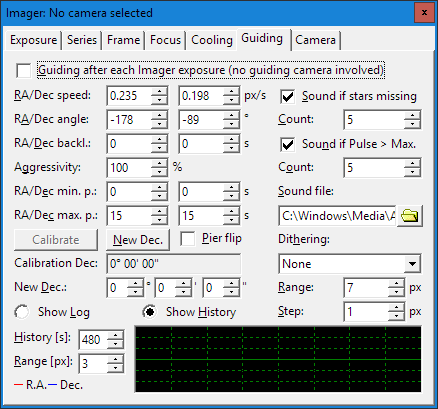
Inter-image guiding controls in the
Guiding tab of the Imager Camera tool
window Advanced reconstruction of color information of
single-shot-color cameras
Color CCD detectors have red, green and blue filters
applied directly on individual pixels (so-called Bayer
mask).
Schematic diagram of color CCD detector with Bayer
mask (left) and magnified crop of raw image captured by
color camera (right) Every pixel registers light of particular color only (red,
green or blue). But color image should contain all three
colors for every pixel. So it is necessary to calculate
missing information from values of neighboring pixels.
There are many ways how to calculate missing color
values — from simple extending of colors
to neighboring pixels (this method leads to coarse images with
visible color errors) to methods based on bi-linear or
bi-cubic interpolation to even more advanced multi-pass
methods etc.
Bi-linear interpolation provides significantly better
results than simple extending of color information to
neighboring pixels and still it is fast enough. But if the
telescope/lens resolution is close to the size of individual
pixels, color artifacts appear close to fine details, as
demonstrated by the image below left.
The above raw image with colors calculated using
bi-linear interpolation (left) and the same raw image, but
now processed by the multi-pass de-mosaic algorithm
(right) Multi-pass algorithm is significantly slower compared to
single-pass bi-linear interpolation, but the resulting image
is much better, especially in fine details. This method allows
using of color camera resolution to its limits.
SIPS offers choosing of color image interpolation method in
both “Image Transform” and “New Image Transform”
tools. For fast image previews or if the smallest details are
significantly bigger than is the pixel size (be it due to
seeing or resolution of the used telescope/lens) the fast
bi-linear interpolation is good enough. But the best results
can be achieved using multi-pass method.
Shipping and Packaging
G2 CCD cameras are supplied in the foam-filled, hard
carrying case containing:
Camera body with a user-chosen telescope adapter. The
standard 2" barrel adapter is included by default. If ordered,
the filter wheel is already mounted inside the camera head and
filters are threaded into place (if ordered). A 100-240 V AC input, 12 V DC output
“brick” adapter with 1.8 m
long power cable. 5 m long USB A-B cable for
connecting camera to host PC. USB Flash Drive with camera drivers, SIPS software
package with electronic documentation and PDF version of
User's Manual. A printed copy of camera User's Manual
G2 CCD cameras are shipped in the foam-filled carrying
case (left), larger case is used if camera is ordered with
external filter wheel (right) Image Galleries
Example images captured with G2 cameras.
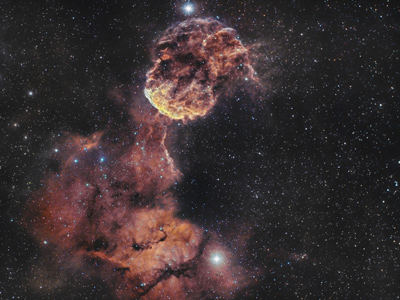 |
| Object |
IC443 “Jellyfish nebula” |
| Author |
Nicolas Kizilian |
| Camera |
G2-8300 |
| Filters |
Halpha, OIII |
| Exposure |
8.5 hours |
| Telescope |
William Optics Zenithstar 66 |
|
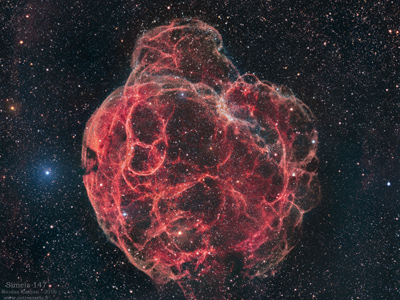 |
| Object |
Simeis 147 supernova remnant |
| Author |
Nicolas Kizilian |
| Camera |
G2-8300 |
| Filters |
Halpha, OIII |
| Exposure |
42 hours |
| Telescope |
William Optics Zenithstar 66 |
|
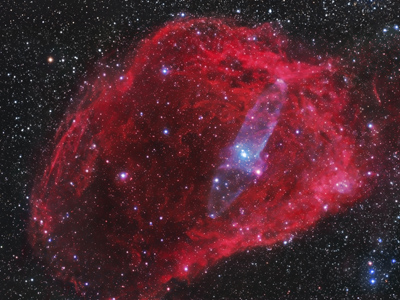 |
| Object |
NGC 6939, NGC 6946, Barnard 150, Sharpless 129,
Ou4, VdB 140 |
| Author |
Nicolas Kizilian |
| Camera |
G2-8300 |
| Filters |
RGB, narrow-band |
| Exposure |
47 hours |
| Telescope |
William Optics Zenithstar 66 |
|
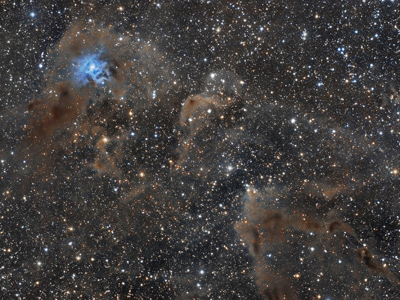 |
| Object |
NGC7023 “Iris” nebula |
| Author |
Nicolas Kizilian |
| Camera |
G2-8300 |
| Filters |
Astrodon LRGM |
| Exposure |
6 hours |
| Telescope |
William Optics Zenithstar 66 |
|
 |
| Object |
IC1396 “Elephant trunk” nebula |
| Author |
Nicolas Kizilian |
| Camera |
G2-8300 |
| Filters |
Halpha, OIII |
| Exposure |
6 hours |
| Telescope |
William Optics Zenithstar 66 |
|
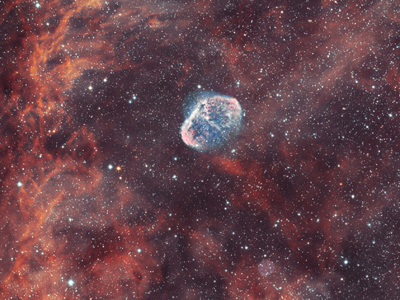 |
| Object |
NGC6888 “Crescent” nebula and “Soap
bubble” nebula |
| Author |
Nicolas Kizilian |
| Camera |
G2-8300 |
| Filters |
Hα, OIII |
| Exposure |
9 hours |
| Telescope |
William Optics Zenithstar 66 |
|
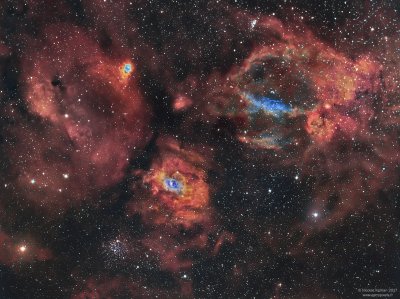 |
| Object |
NGC7635 “Bubble” nebula and
surroundings |
| Author |
Nicolas Kizilian |
| Camera |
G2-8300 |
| Filters |
Astrodon Hα,OIII |
| Exposure |
10.5 hours |
| Telescope |
William Optics Zenithstar 66 |
|
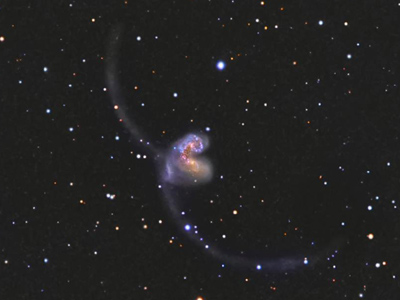 |
| Object |
NGC 4038 “Antennae” |
| Author |
Marco Burali |
| Camera |
G2-4000 |
| Filters |
LRGB |
| Exposure |
3 hours |
| Telescope |
TOA 150, f/5.8 |
|
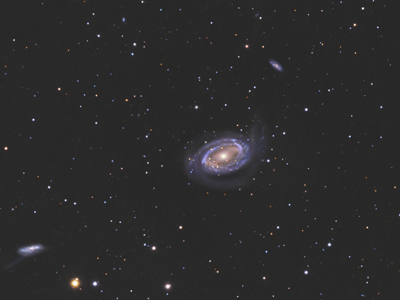 |
| Object |
NGC4725, NGC4712, NGC4747 |
| Author |
Marco Burali |
| Camera |
G2-4000 |
| Filters |
LRGB |
| Exposure |
5 hours |
| Telescope |
TSA 120, f/5.8 |
|
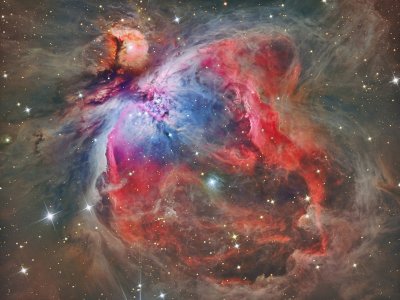 |
| Object |
M42 “Great Orion Nebula” |
| Author |
Reinhold Wittich |
| Camera |
G2-8300 |
| Filters |
LRGB, Hα, OIII and
SII |
| Exposure |
more than 10 hours |
| Telescope |
300 mm
Newtonian |
|
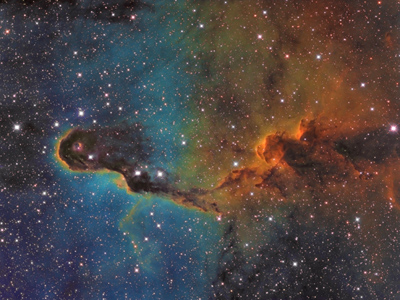 |
| Object |
“Elephant Trunk” nebula, part of
nebulosity complex IC1396 in Cepheus |
| Author |
Martin Myslivec |
| Camera |
G2-8300 |
| Filters |
Hα, OIII and SII |
| Exposure |
28 hours |
| Telescope |
300 mm
f/4.5 astrograph |
|
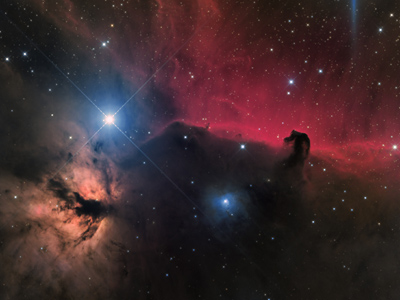 |
| Object |
“Flame” and “Horse Head” nebulae in
Orion |
| Author |
Jan Camek |
| Camera |
G2-8300 |
| Filters |
Astrodon Ha, Baader LRGB |
| Exposure |
7.2 hours |
| Telescope |
300 mm
f/2.9 astrograph |
|
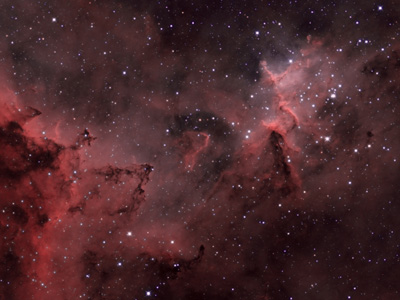 |
| Object |
IC1805 nebula complex |
| Author |
Jan Camek |
| Camera |
G2-8300 |
| Filters |
Astrodon Ha+OIII (bi-color) |
| Exposure |
14 hours |
| Telescope |
300 mm
f/2.9 astrograph |
|
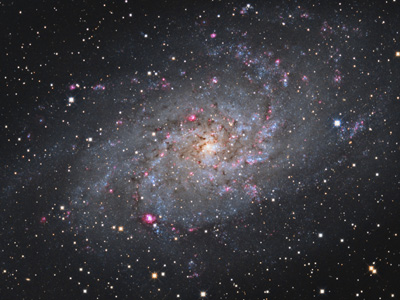 |
| Object |
M33 “Triangulum galaxy” |
| Author |
Jan Camek |
| Camera |
G2-8300 |
| Filters |
Astrodon Ha+OIII, Baader LRGB, IDAS LPS2 |
| Exposure |
12 hours |
| Telescope |
300 mm
f/2.9 astrograph |
|
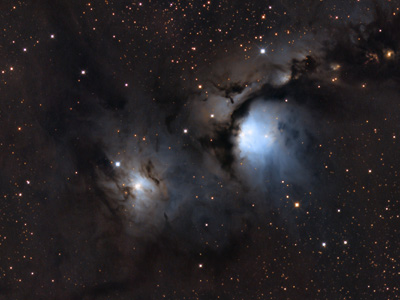 |
| Object |
M78 nebula |
| Author |
Jan Camek |
| Camera |
G2-8300 |
| Filters |
Baader LRGB |
| Exposure |
6.2 hours |
| Telescope |
300 mm
f/2.9 astrograph |
|
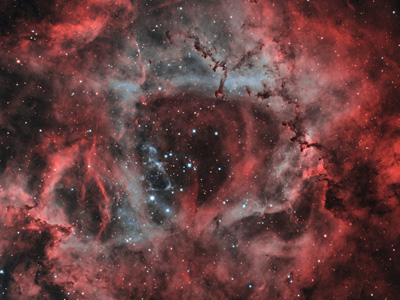 |
| Object |
NGC2244 “Rosette” nebula |
| Author |
Jan Camek |
| Camera |
G2-8300 |
| Filters |
Astrodon Ha 5nm, OIII 3nm (bi-color) |
| Exposure |
9 hours |
| Telescope |
300 mm
f/2.9 astrograph |
|
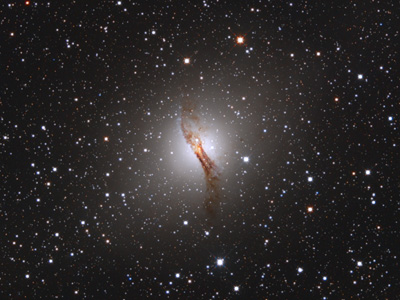 |
| Object |
NGC5128 “Centaurus A” galaxy |
| Author |
Jan Camek |
| Camera |
G2-8300 |
| Filters |
Baader LRGB |
| Exposure |
6.6 hours |
| Telescope |
300 mm
f/2.9 astrograph |
|
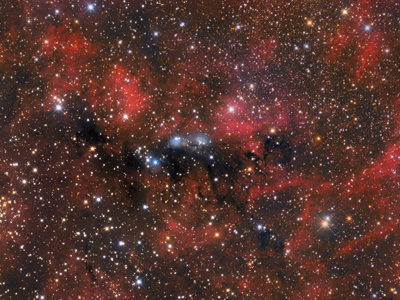 |
| Object |
NGC6914 nebula complex |
| Author |
Jan Camek |
| Camera |
G2-8300 |
| Filters |
Baader LRGB |
| Exposure |
6 hours |
| Telescope |
300 mm
f/2.9 astrograph |
|
 |
| Object |
WR134, nebulosity around a Wolf Rayet star in
Cygnus |
| Author |
Tommy Nawratil |
| Camera |
G2-8300 (LRGB + Hα +
OIII filters) |
| Telescope |
10 inch f/4
Newton |
|
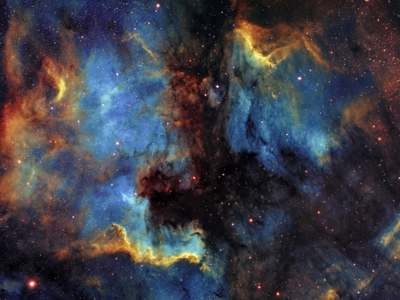 |
| Object |
NGC7000 “North America” a IC5070
“Pelican” |
| Author |
Ondrej Podlucky |
| Camera |
G2-8300 (+ narrow-band filters) |
| Exposure |
43 hours (mosaic of two
frames) |
| Telescope |
Borg 101ED + F4ED reducer |
|
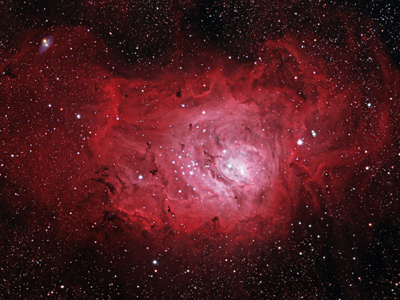 |
| Object |
M8 “Lagoon” |
| Author |
David Kennedy |
| Camera |
G2-8300 (+ Ha, R, G, B filters) |
| Exposure |
9.5 hours |
| Telescope |
Borg 60ED |
|
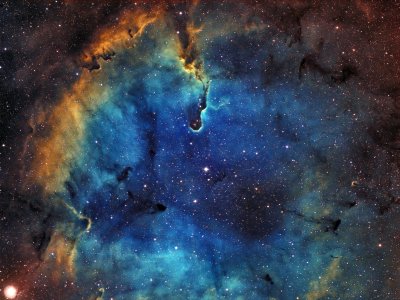 |
| Object |
IC1396 “Elephant's trunk” |
| Author |
Ondrej Podlucky |
| Camera |
G2-8300 (+ narrow-band filters) |
| Exposure |
27 hours |
| Telescope |
Borg 101ED + F4ED reducer |
|
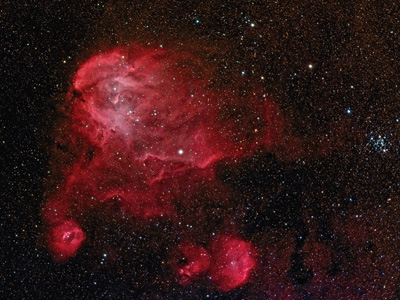 |
| Object |
Lambda Centauri region |
| Author |
David Kennedy |
| Camera |
G2-8300 (+ Ha, R, G, B filters) |
| Exposure |
8.9 hours |
| Telescope |
71fl miniBorg F/7.8 |
|
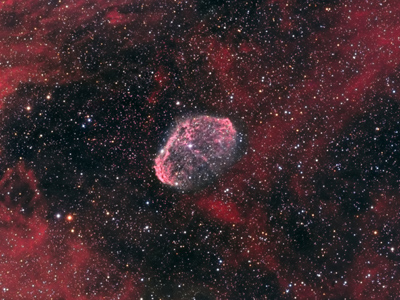 |
| Object |
NGC6888 Crescent nebula |
| Author |
Jonas Fiedler |
| Camera |
G2-8300 (+ Ha, R, G, B filters) |
| Exposure |
4.5 hours |
| Telescope |
Takahashi FSQ 106 |
|
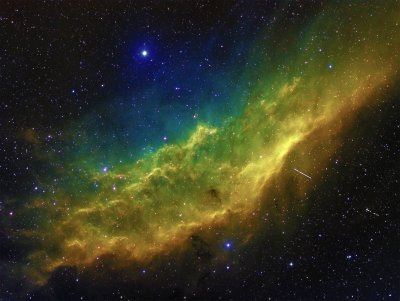 |
| Object |
NGC1499 California Nebula |
| Author |
Ondrej Podlucky |
| Camera |
G2-8300 (+ narrow-band filters) |
| Exposure |
28 hours |
| Telescope |
Borg 101ED + F4ED reducer |
|
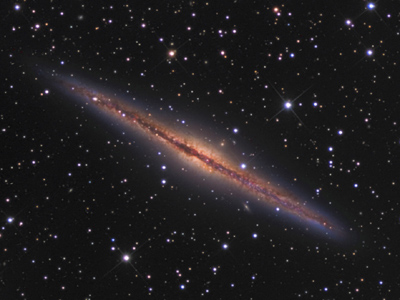 |
| Object |
NGC891 |
| Author |
Stefano Campani |
| Camera |
G2-8300 with Hα and RGB
filters |
| Exposure |
6.4 hours |
| Telescope |
24" (610 mm) RNT
Newton |
|
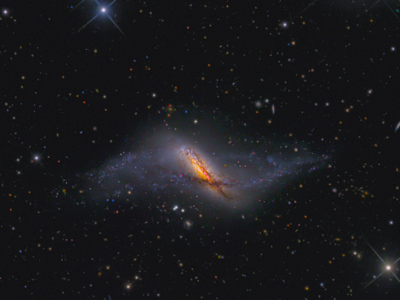 |
| Object |
NGC660 |
| Author |
Stefano Campani |
| Camera |
G2-8300 with Hα and RGB
filters |
| Exposure |
10.6 hours |
| Telescope |
24" (610 mm) RNT
Newton |
|
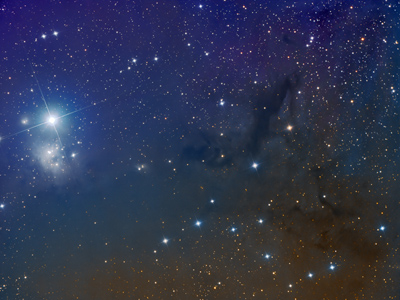 |
| Object |
IC348 |
| Author |
Miloš Hroch |
| Camera |
G2-8300 |
| Telescope |
200 mm, f/2.9
astrograph (f/4 mirror + 0.73×
ASA corrector) |
|
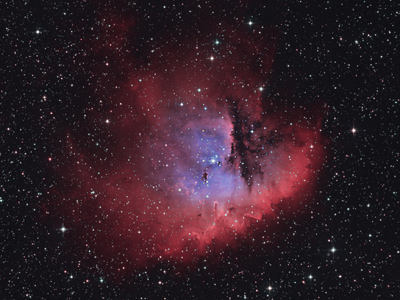 |
| Object |
NGC281 “Pacman nebula” |
| Author |
Miloš Hroch |
| Camera |
G2-8300 |
| Telescope |
200 mm, f/2.9
astrograph (f/4 mirror + 0.73×
ASA corrector) |
|
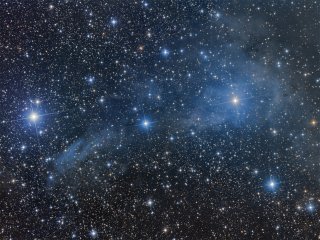 |
| Object |
VdB14, VdB15 |
| Author |
Miloš Hroch |
| Camera |
G2-8300 |
| Telescope |
200 mm, f/2.9
astrograph (f/4 mirror + 0.73×
ASA corrector) |
|
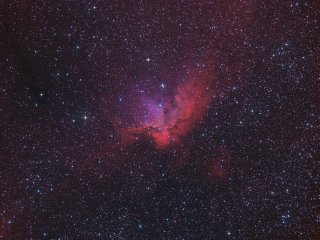 |
| Object |
NGC7380 “Wizard nebula” |
| Author |
Miloš Hroch |
| Camera |
G2-8300 |
| Telescope |
200 mm, f/2.9
astrograph (f/4 mirror + 0.73×
ASA corrector) |
|
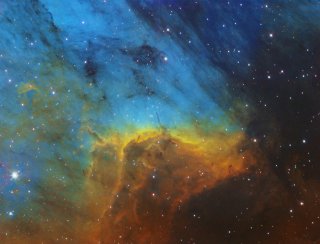 |
| Object |
IC5070 “Pelican Nebula” |
| Author |
Thomas Jäger |
| Camera |
G2-8300 |
| Telescope |
12" (305 mm) f/3.8
astrograph |
|
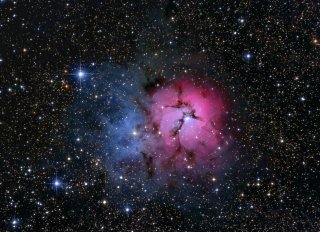 |
| Object |
M20 “Trifid” |
| Author |
David Kennedy |
| Camera |
G2-8300 |
| Telescope |
Vixen VC200L with reducer |
|
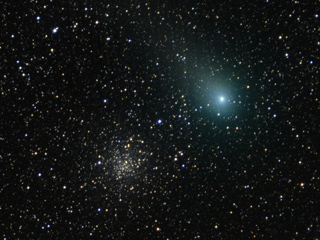 |
| Object |
Comet C2009 P1 Garradd and M71 |
| Author |
Martin Myslivec |
| Camera |
G2-8300 |
| Telescope |
185mm f/3.9 astrograph |
|
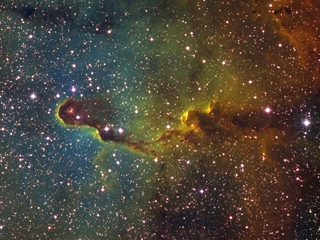 |
| Object |
IC1396 “Elephant Trunk” |
| Author |
Martin Myslivec |
| Camera |
G2-8300 (+narrow-band filters) |
| Telescope |
185mm f/3.9 astrograph |
|
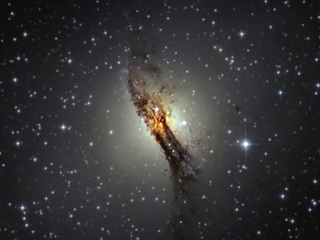 |
| Object |
NGC5128 “Centaurus A” |
| Author |
David Kennedy |
| Camera |
G2-8300 |
| Telescope |
Vixen VC200L with reducer |
|
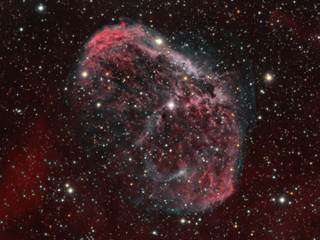 |
| Object |
NGC6888 “Crescent Nebula” |
| Author |
Patrick Hochleitner and Dieter Beer |
| Camera |
G2-8300 |
| Telescope |
Skywatcher BD 120ED + 0,85 flattener |
|
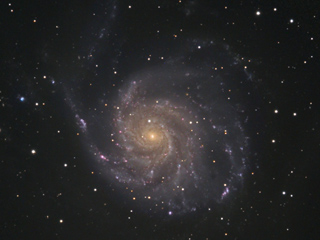 |
| Object |
M101 |
| Author |
Christoph Gerhard |
| Camera |
G2-8300 |
| Telescope |
7-inch Maksutov |
|
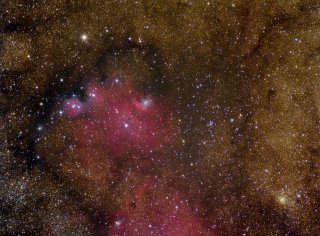 |
| Object |
NGC6559 |
| Author |
Resa Ghanawistschi |
| Camera |
G2-8300 |
| Telescope |
Pentax 75SDHF |
|
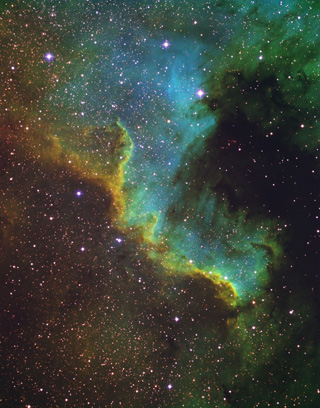 |
| Object |
NGC7000 “North America” |
| Author |
Martin Myslivec |
| Camera |
G2-8300 (+ narrow-band filters) |
| Telescope |
185mm f/3.9 astrograph |
|
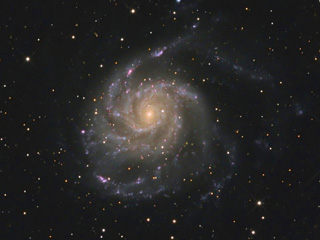 |
| Object |
M101 |
| Author |
Manferd Fischer |
| Camera |
G2-8300 |
| Telescope |
ASA N8 |
|
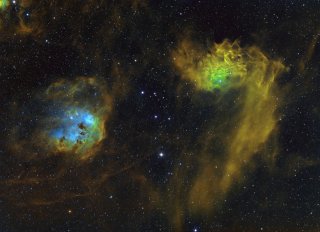 |
| Object |
IC405, IC410 |
| Author |
Ondrej Podlucky |
| Camera |
G2-8300 (+ narrow-band filters) |
| Telescope |
Borg 101ED + F4ED reducer |
|
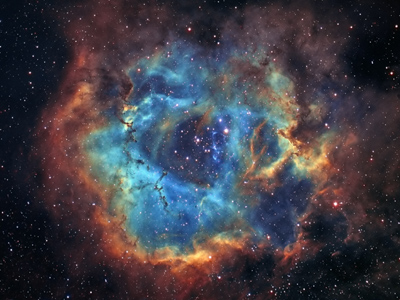 |
| Object |
NGC2237 “Rosette” |
| Author |
Ondrej Podlucky |
| Camera |
G2-8300 (+ narrow-band filters) |
| Telescope |
Borg 101ED + F4ED reducer |
|
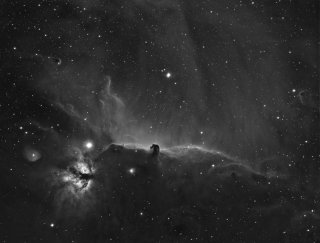 |
| Object |
IC434 “Horse Head” |
| Author |
Ondrej Podlucky |
| Camera |
G2-8300 (+ Hα) |
| Telescope |
Borg 101ED + F4ED reducer |
|
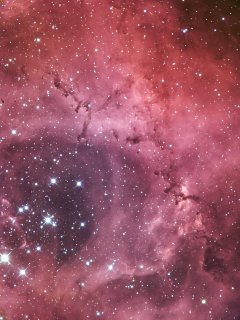 |
| Object |
NGC2237 “Rosette” |
| Author |
Tsutomu Chikazawa |
| Camera |
G2-8300 |
| Telescope |
Orion CT10 Newtonian |
|
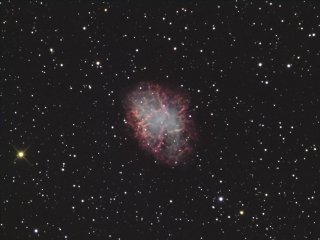 |
| Object |
M1 “Crab Nebula” |
| Author |
Tsutomu Chikazawa |
| Camera |
G2-8300 |
| Telescope |
Orion CT10 Newtonian |
|
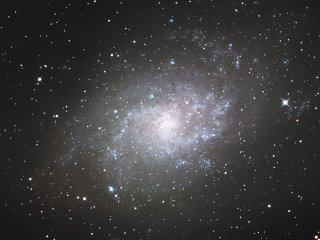 |
| Object |
M33 |
| Author |
Tsutomu Chikazawa |
| Camera |
G2-8300 |
| Telescope |
Orion CT10 Newtonian |
|
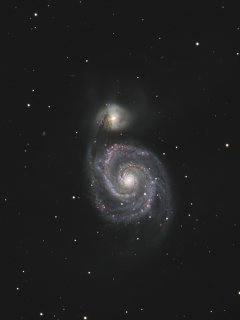 |
| Object |
M51 “Whirlpool Galaxy” |
| Author |
Tsutomu Chikazawa |
| Camera |
G2-8300 |
| Telescope |
Orion CT10 Newtonian |
|
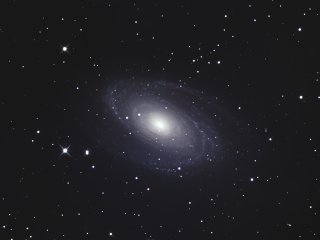 |
| Object |
M81 “Boode Galaxy” |
| Author |
Tsutomu Chikazawa |
| Camera |
G2-8300 |
| Telescope |
Orion CT10 Newtonian |
|
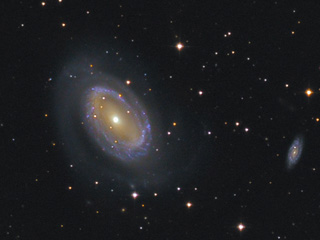 |
| Object |
NGC4725 |
| Author |
Martin Myslivec |
| Camera |
G2-8300 |
| Telescope |
185mm f/3.9 astrograph |
|
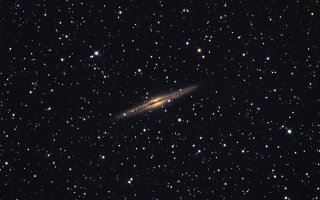 |
| Object |
NGC891 |
| Author |
Pavel Cagas |
| Camera |
G2-8300 |
| Telescope |
250mm f/5.4 Newton |
|
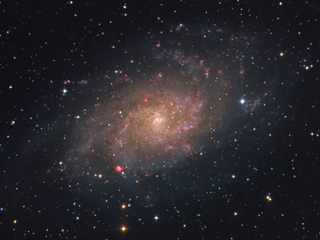 |
| Object |
M33 |
| Author |
Martin Myslivec |
| Camera |
G2-8300 |
| Telescope |
185mm f/3.9 astrograph |
|
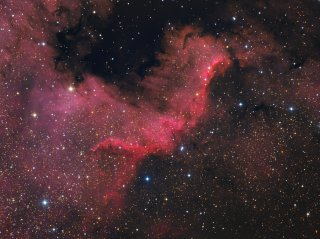 |
| Object |
NGC7000 “North America” |
| Author |
Martin Myslivec |
| Camera |
G2-8300 |
| Telescope |
185mm f/3.9 astrograph |
|
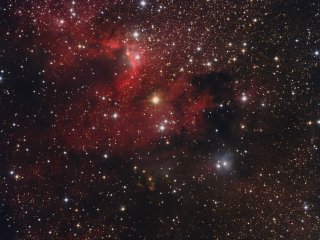 |
| Object |
“Cave Nebula” |
| Author |
Martin Myslivec |
| Camera |
G2-8300 |
| Telescope |
185mm f/3.9 astrograph |
|
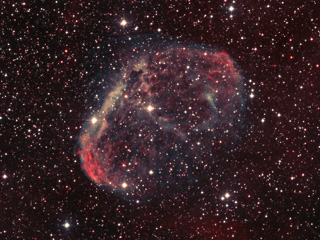 |
| Object |
NGC6888 “Crescent” (bi-color) |
| Author |
Martin Myslivec |
| Camera |
G2-8300 |
| Telescope |
185mm f/3.9 astrograph |
|
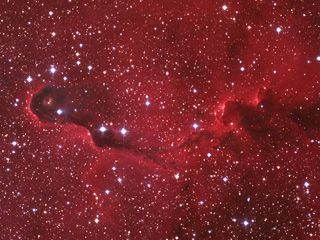 |
| Object |
IC1396 “Elephant Trunk” |
| Author |
Martin Myslivec |
| Camera |
G2-8300 |
| Telescope |
185mm f/3.9 astrograph |
|
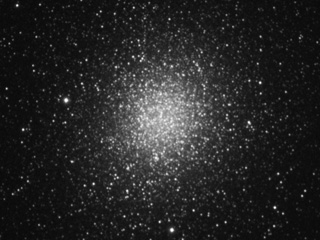 |
| Object |
“Omega Centauri” cluster |
| Author |
Robert Knox |
| Camera |
G2-8300 |
| Telescope |
110mm Borg ED |
|
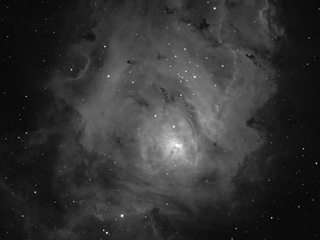 |
| Object |
M8 “Lagoon Nebula” |
| Author |
Robert Knox |
| Camera |
G2-8300 (+ Hα) |
| Telescope |
110mm Borg ED |
|
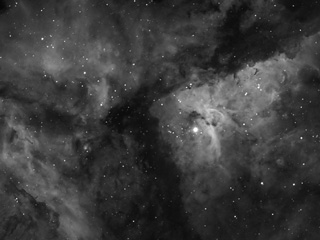 |
| Object |
Eta Cariane nebula |
| Author |
Robert Knox |
| Camera |
G2-8300 (+ Hα) |
| Telescope |
110mm Borg ED |
|
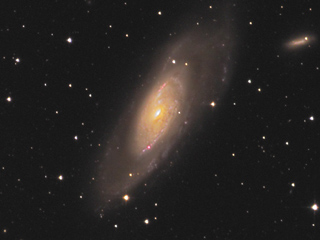 |
| Object |
M106 |
| Author |
Martin Myslivec |
| Camera |
G2-8300 |
| Telescope |
185mm f/3.9 astrograph |
|
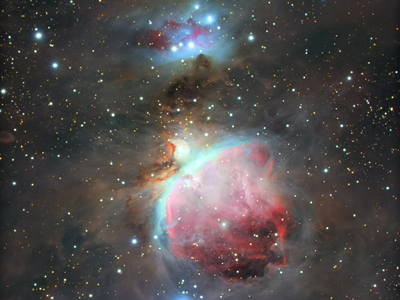 |
| Object |
M42 Orion Nebula |
| Author |
Samuele Gasparini |
| Camera |
G2-4000 |
| Telescope |
SkyWatcher 80ED + 0.85× flattener |
|
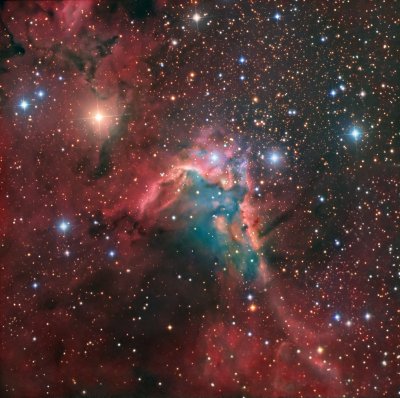 |
| Object |
SH2 155 |
| Author |
Marco Burali |
| Camera |
G2-4000 (Hα + OIII +
RGB) |
| Telescope |
BRC 250 F5 |
|
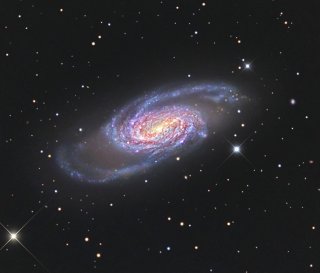 |
| Object |
NGC2903 |
| Author |
Marco Burali |
| Camera |
G2-4000 |
| Telescope |
Takahashi TOA 150 F7 |
|
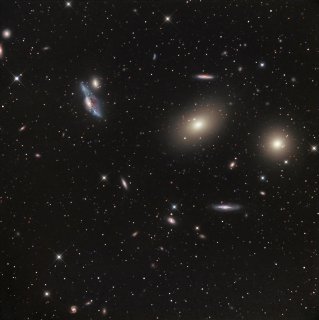 |
| Object |
Virgo Galaxy Cluster |
| Author |
Marco Burali |
| Camera |
G2-4000 |
| Telescope |
Takahashi TOA 150 F7 |
|
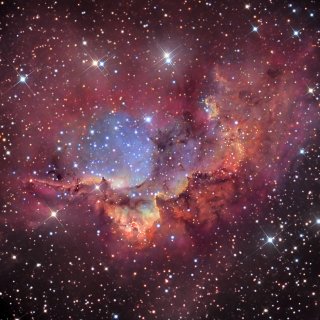 |
| Object |
NGC7380 |
| Author |
Marco Burali |
| Camera |
G2-4000 |
| Telescope |
Takahashi TOA 150 F7 |
|
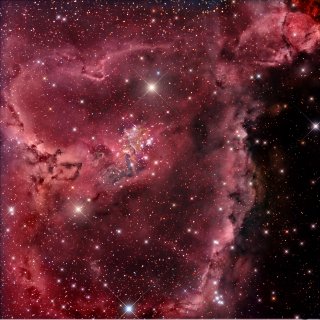 |
| Object |
IC1805 |
| Author |
Marco Burali |
| Camera |
G2-4000 |
| Telescope |
Takahashi TOA 150 F7 |
|
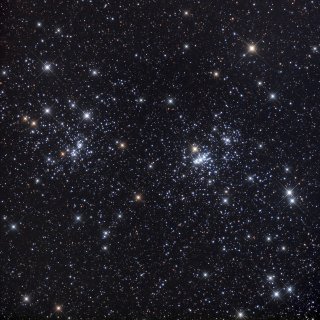 |
| Object |
NGC884 a NGC869 |
| Author |
Marco Burali |
| Camera |
G2-4000 |
| Telescope |
Takahashi TOA 150 F7 |
|
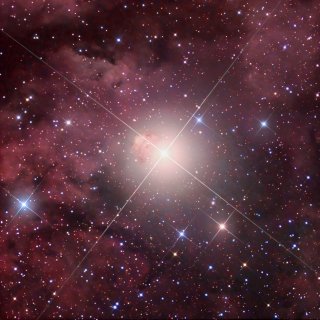 |
| Object |
Gama Cygni |
| Author |
Marco Burali |
| Camera |
G2-4000 |
| Telescope |
Takahashi TOA 150 F7 |
|
G2-0402, G2-1600 and G2-3200 Image Gallery
G2 CCD cameras with KAF detectors are primarily intended
for research work. They are only occasionally used for
“aesthetics astrophotography”. Following examples
represent both science observations and astrophotography
images.
Astronomy research
G2 cameras are appreciated by both professional
researchers and amateur astronomers involved in scientific
observations. Here are only a few examples, chosen from
huge amount of observations, be it extragalactic novae
discovery, minor planet photometry and astrometry,
variable star discovery and regular observations,
exoplanet transit observations etc.
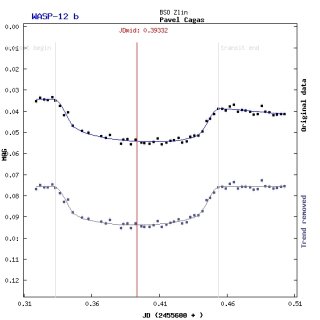 |
| Object |
WASP 12b exoplanet transit
observation |
| Author |
Pavel Cagas |
| Camera |
G2-3200 |
| Telescope |
250mm f/5.4 reflector |
|
Only 0.8mmag RMS difference from ideal light
cure 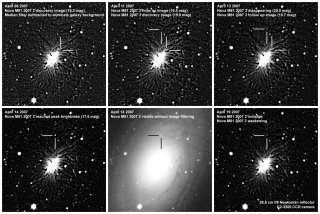 |
| Object |
Two new novae in M81 galaxy discovered
within three days |
| Author |
Pavel and Petr Cagas, Vaclav Pribik |
| Camera |
G2-3200 |
| Telescope |
265mm f/8 reflector |
|
This discovery is a record in the size of
telescope, used to discover nova in M81. The second
smallest has 750mm diameter. 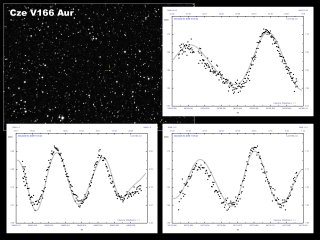 |
| Object |
New discovery of HADS (High Amplitude
Delta Scuti) variable star |
| Author |
Vaclav Pribik |
| Camera |
G2-1600 |
| Telescope |
254mm f/4.7 reflector |
|
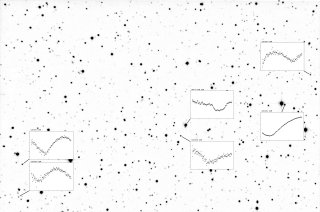 |
| Object |
5 new variable stars discovered during
HAT-P 20b exoplanet transit observations |
| Author |
Vaclav Pribik |
| Camera |
G2-1600 |
| Telescope |
254mm f/4.7 reflector |
|
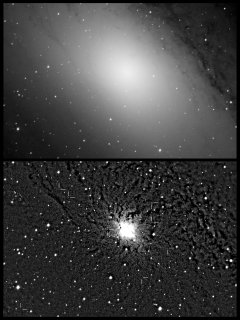 |
| Object |
9 novae in M31 galaxy |
| Author |
Kamil Hornoch |
| Camera |
G2-3200 |
| Telescope |
650mm f/3.6 reflector |
|
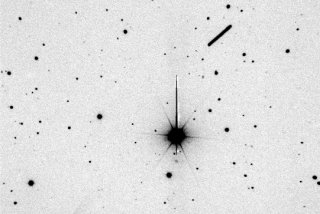 |
| Object |
Minor planet 2007/TU24 passing close to
Earth |
| Author |
Peter Kusnirak |
| Camera |
G2-3200 |
| Telescope |
650mm f/3.6 reflector |
|
Microscopy and material science
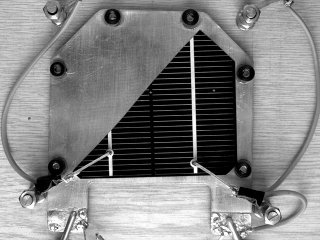 |
| Object |
Solar cell sample — visible light |
| Author |
Faculty of Electrical Engineering and
Communication, Brno University of Technology |
| Camera |
G2-3200 |
|
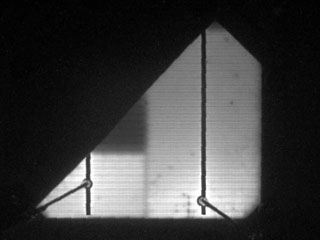 |
| Object |
Solar cell sample — near IR, conductive direction |
| Author |
Faculty of Electrical Engineering and
Communication, Brno University of Technology |
| Camera |
G2-3200 |
|
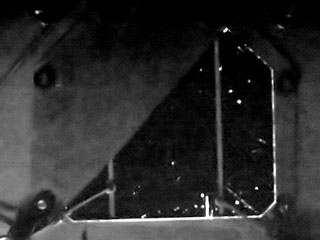 |
| Object |
Solar cell sample — near IR, micro-plasmas in barrier
direction |
| Author |
Faculty of Electrical Engineering and
Communication, Brno University of Technology |
| Camera |
G2-3200 |
|
Near-IR radiation of semiconductor (solar cell)
samples 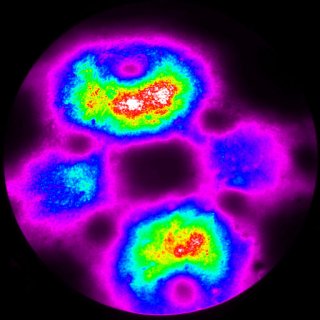 |
| Object |
Palladium layer on the tungsten sample
covered by tungsten oxide |
| Author |
J. Heyrovský Institute of Physical
Chemistry |
| Camera |
G2-0402 |
|
Field emission microscope images, camera field
of view is 800nm (1.5nm/pixel). Astrophotography
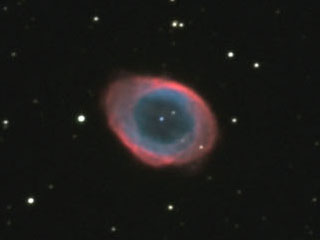 |
| Object |
M57 "Ring" nebula |
| Author |
Pavel Cagas |
| Camera |
G2-3200 |
| Telescope |
265mm f/8 Newtonian |
|
 |
| Object |
M27 "Dumbbell" nebula |
| Author |
Pavel Cagas |
| Camera |
G2-3200 |
| Telescope |
265mm f/8 Newtonian |
|
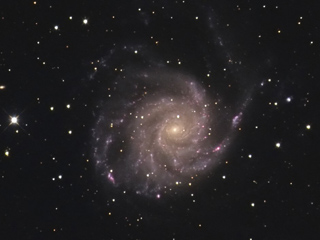 |
| Object |
M101 galaxy |
| Author |
Martin Myslivec |
| Camera |
G2-3200 |
| Telescope |
185mm f/3.9 astrograph |
|
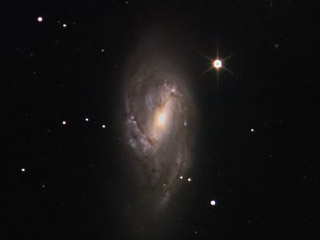 |
| Object |
M66 galaxy |
| Author |
Pavel Cagas |
| Camera |
G2-1600 |
| Telescope |
265mm f/8 Newtonian |
|
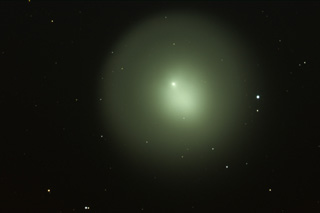 |
| Object |
Comet "Holmes" |
| Author |
Pavel Cagas |
| Camera |
G2-1600 |
| Telescope |
265mm f/8 Newtonian |
|
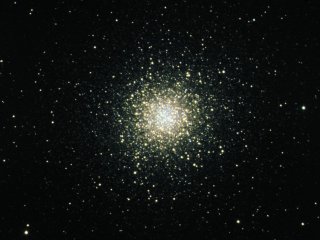 |
| Object |
Globular cluster M13 |
| Author |
Pavel and Petr Cagas |
| Camera |
G2-3200 |
| Telescope |
265mm f/8 Newtonian |
|
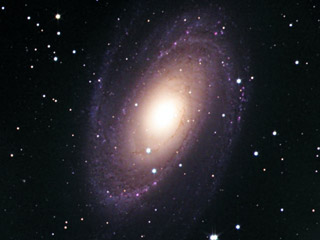 |
| Object |
M81 "Boode galaxy" |
| Author |
Pavel and Petr Cagas, Vaclav Pribik |
| Camera |
G2-3200 |
| Telescope |
265mm f/8 Newtonian |
|
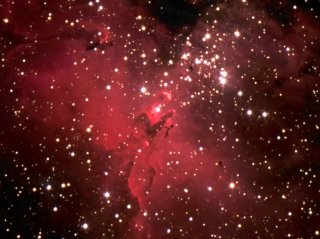 |
| Object |
M16 "Eagle nebula" |
| Author |
Pavel and Petr Cagas |
| Camera |
G2-3200 |
| Telescope |
265mm f/8 Newtonian |
|
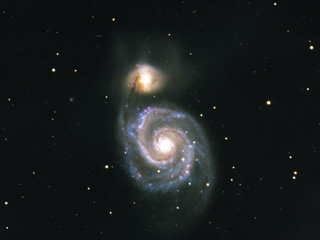 |
| Object |
M51 "Whirlpool galaxy" |
| Author |
Pavel and Petr Cagas |
| Camera |
G2-3200 |
| Telescope |
265mm f/8 Newtonian |
|
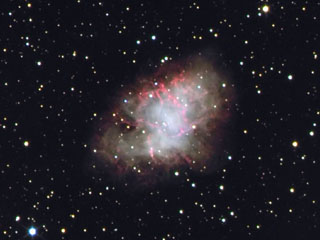 |
| Object |
M1 "Crab nebula" |
| Author |
Pavel Cagas |
| Camera |
G2-3200 |
| Telescope |
265mm f/8 Newtonian |
|
All images published with permission of their respective
authors.
| 